More than 50 years ago, NASA sent the first humans to the Moon under the Apollo program. Now, NASA is preparing to send the first woman and first person of color to the lunar surface as part of the Artemis program. Follow along as we show you then-and-now images of the Apollo and Artemis hardware here at the Kennedy Space Center as we prepare for our next giant leap in exploration.

On the left, the Apollo 17 crew – NASA astronauts Ronald Evans (left), Harrison Schmitt (center), and Eugene Cernan (right) – stand on the crew access arm for one of the pre-launch activities at Launch Complex 39A at the agency’s Kennedy Space Center in Florida while participating in an emergency egress test. The Apollo 17 mission, which launched Dec. 7, 1972 from Kennedy, marked the final lunar landing mission for the Apollo program. Photo credit: NASA
On the right, the Artemis II crew – NASA astronaut Victor Glover (left), CSA (Canadian Space Agency) astronaut Jeremy Hansen, and NASA astronauts Christina Koch and Reid Wiseman – stand on the crew access arm of the mobile launcher at Launch Pad 39B as part of an integrated ground systems test for the Artemis II mission on Sept. 20, 2023. The test ensured the ground systems team is ready to support the crew timeline on launch day for the first crewed mission under Artemis. Photo credit: NASA/Frank Michaux
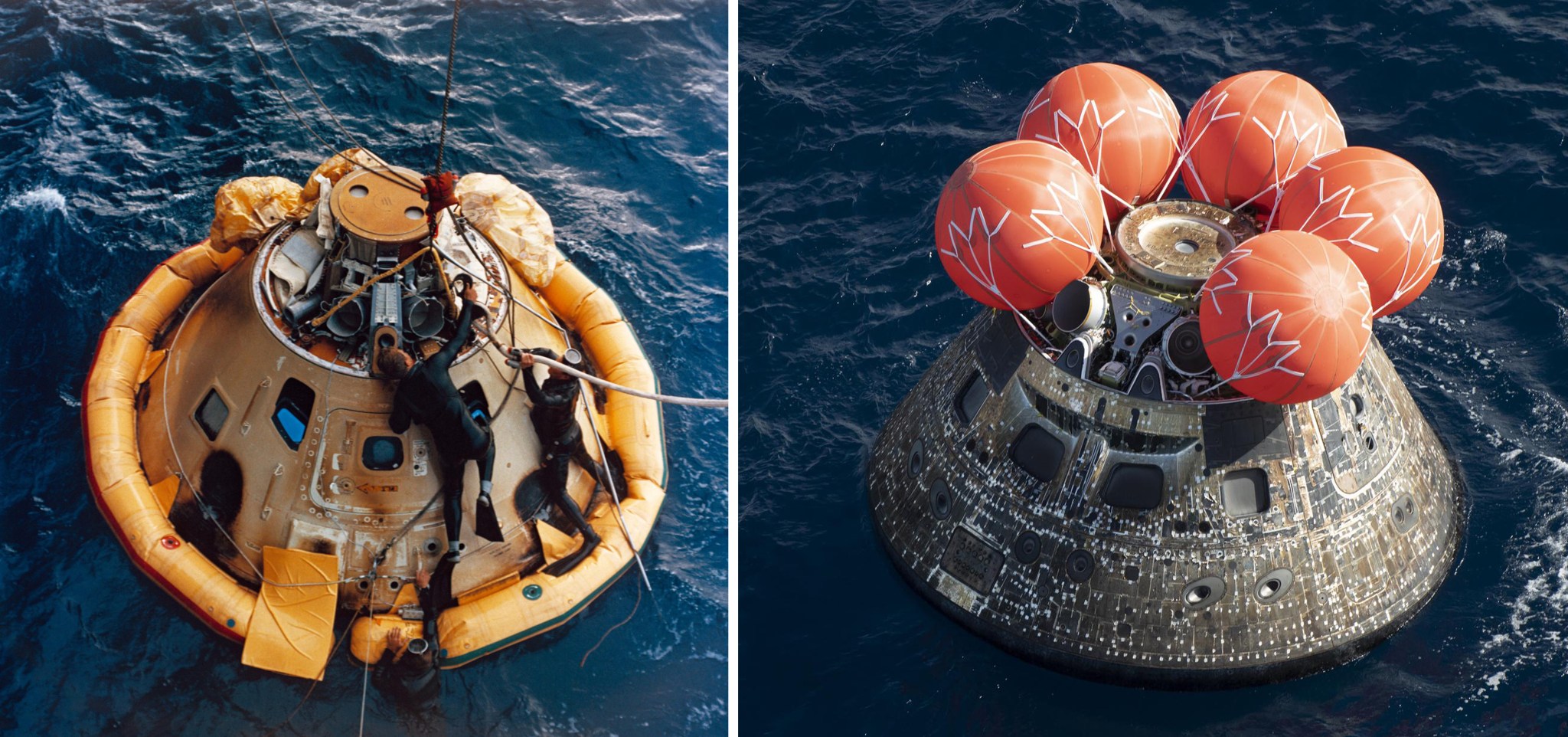
On the left, team members from the U.S. Navy prepare to take the Apollo spacecraft for NASA’s Apollo 6 mission aboard the USS Okinawa on April 4, 1968, after a successful splashdown in the Pacific Ocean, about 431 miles north of Honolulu, Hawaii. The mission, which lasted nine hours and 57 minutes, marked the third and final uncrewed test flight for the Apollo program. The purpose of the mission was to place the Apollo spacecraft into low-Earth orbit and simulate a translunar injection by sending the spacecraft into a highly elliptical Earth orbit. Following the maneuver, the service module engine slowed the spacecraft down to simulate a direct-return abort and head back to Earth. Apollo 6 qualified the Saturn V rocket for future crewed flights.
On the right, NASA’s Orion spacecraft for the Artemis I mission is seen in the Pacific Ocean after successfully splashing down at 12:40 p.m. EST Dec. 11, 2022, off the coast of Baja California. The spacecraft was recovered by the agency’s Landing and Recovery team, the U.S. Navy, and Department of Defense partners aboard the USS Portland. The 25.5-day uncrewed flight test, which launched Nov. 16, 2022, from Launch Pad 39B at the agency’s Kennedy Space Center in Florida, sent Orion around the Moon, surpassing the farthest distance from Earth a spacecraft built for humans has traveled in space before returning home. Photo credit: NASA/James M. Blair
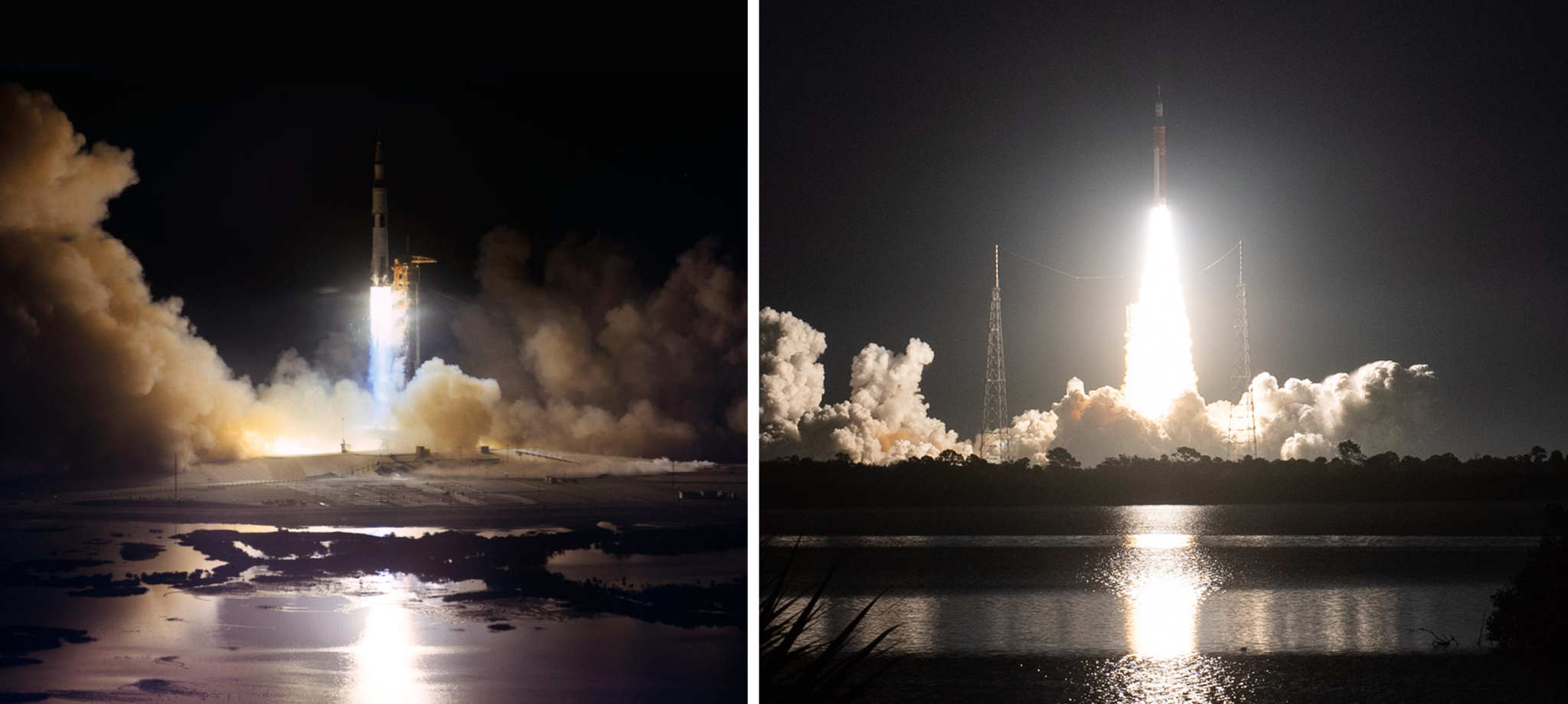
On the left, the 363-foot-tall Apollo 17 Moon rocket launches at 12:33 a.m. EST Dec. 7, 1972, from NASA’s Kennedy Space Center’s Launch Pad 39A. Apollo 17 marked the final lunar landing mission for the Apollo program and the first nighttime launch of the Saturn V rocket. Onboard the spacecraft were astronauts Eugene A. Cernan, who was the commander for the mission, command module pilot Ronald E. Evans, and lunar module pilot Harrison H. Schmitt. Photo credit: NASA
On the right and nearly 50 years after the last lunar mission, the 322-foot-tall Artemis I Moon rocket launches at 1:47 a.m. EST Nov. 16, 2022, from NASA’s Kennedy Space Center’s Launch Pad 39B. At liftoff, the Space Launch System rocket produces 15% more thrust than the Saturn V rocket. Through Artemis, NASA will land the first woman and first person of color on the Moon, using innovative technologies to explore more of the lunar surface than ever before. Photo credit: NASA/Bill Ingalls
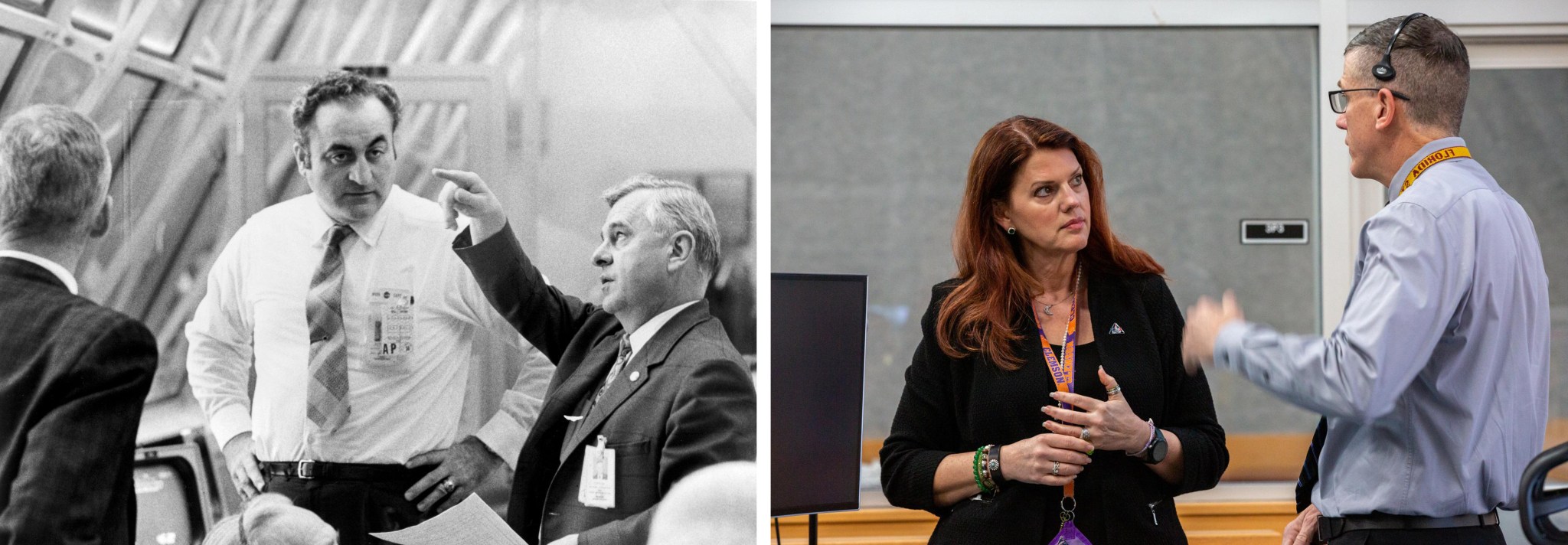
On the left, Walter Kapryan (right), Launch Operations Director, discusses an aspect of the Apollo 14 flight with Rocco A. Petrone (center), Apollo Program Director, inside the Launch Control Center’s (LCC) Firing Room 1 at NASA’s Kennedy Space Center in Florida for the upcoming Apollo 14 mission, which flew NASA astronauts Alan Shepard, Stuart Roosa, and Edgar Mitchell.
On the right, Artemis Launch Director Charlie Blackwell-Thompson (left) and Assistant Artemis Launch Director Jeremy Graeber (right) are seen inside the same firing room for the wet dress rehearsal for the Artemis I mission. Under Apollo, the launch team was primarily comprised of men. Now, as the agency gets ready to return to the Moon under Artemis, the launch team is about 30% women, including first woman launch director, Charlie Blackwell-Thompson. Photo credit: NASA/Cory Huston
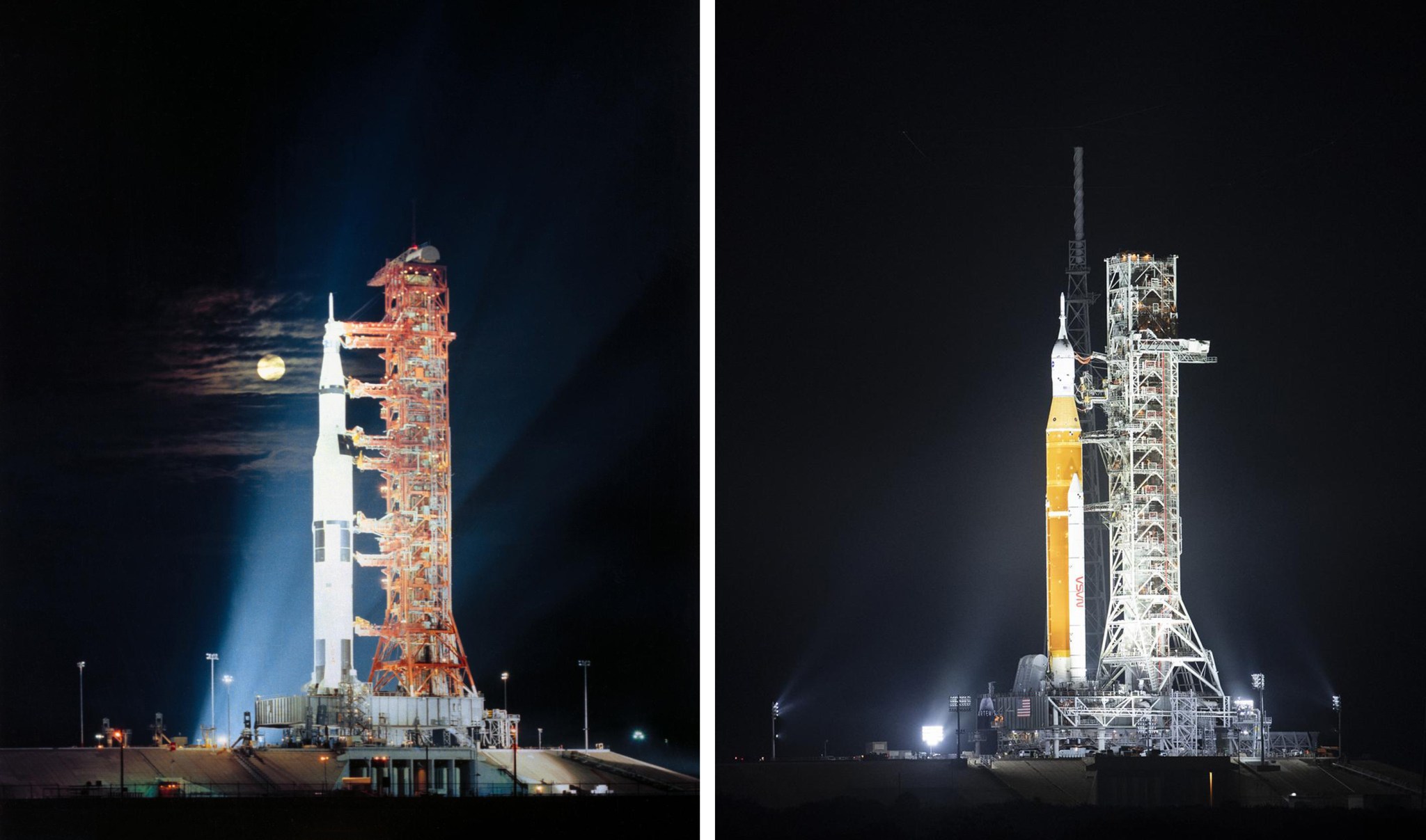
On the left, the Apollo 17 rocket and spacecraft are seen at Launch Pad 39A at NASA’s Kennedy Space Center in Florida. Apollo 17 crew included NASA astronauts Eugene A. Cernan, commander; Ronald E. Evans, command module pilot; and scientist Harrison H. Schmitt, lunar module pilot. The final lunar landing mission in NASA’s Apollo program, Apollo 17 launched Dec. 7, 1972, and marked the most recent time humans set foot on the Moon.
On the right, the Space Launch System rocket and Orion spacecraft on top of the mobile launcher stand tall at Pad 39B on March 18, 2022. The integrated rocket and spacecraft rolled out of the Vehicle Assembly Building for a wet dress rehearsal ahead of the Artemis I launch. Photo credit: NASA/Joel Kowsky
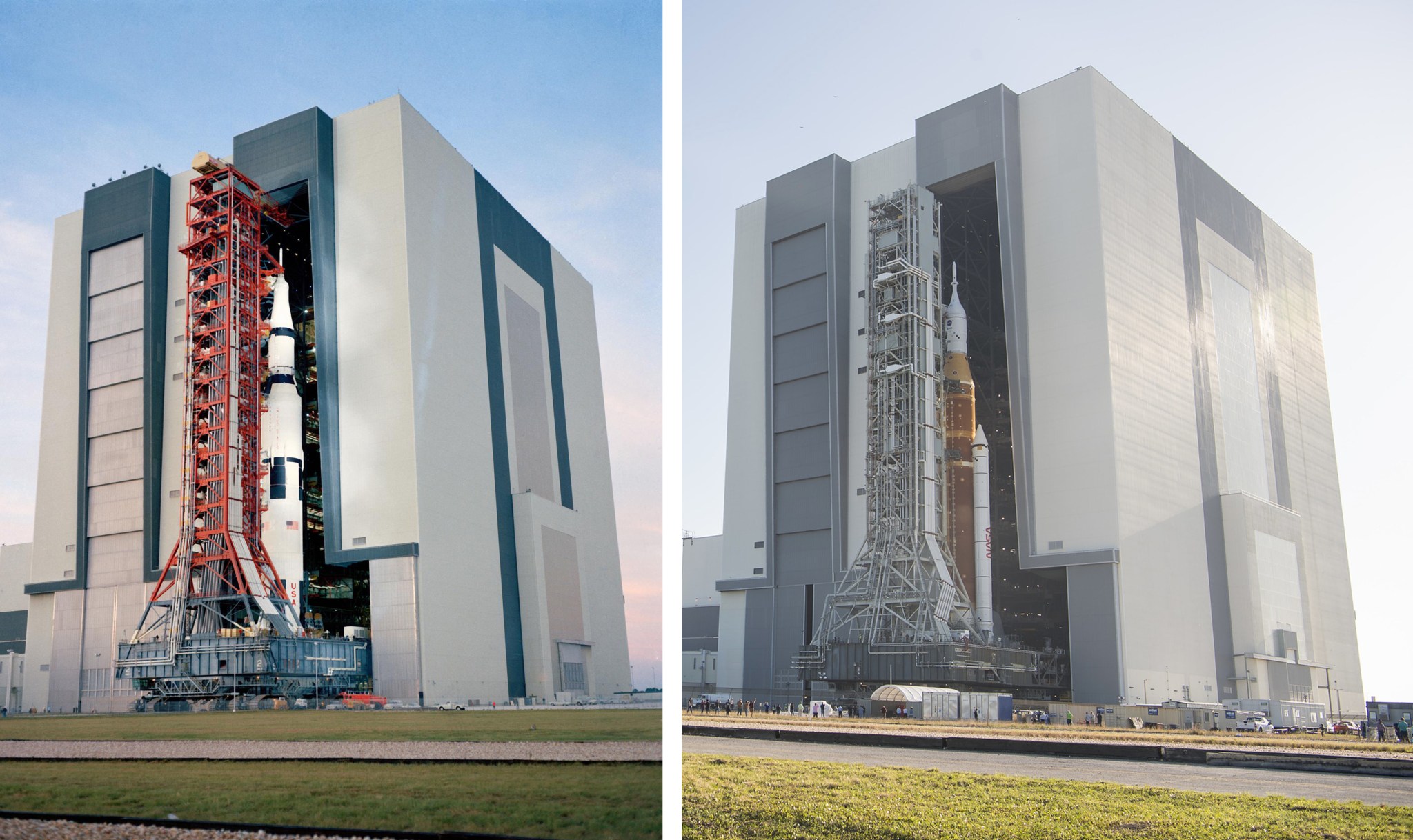
On the left, the Saturn V rocket for the Apollo 14 mission and mobile launch tower atop the crawler-transporter are seen leaving the Vehicle Assembly Building (VAB) and on its way to Launch Pad 39 at the agency’s Kennedy Space Center in Florida. Apollo 14 was launched on Jan. 31, 1971, becoming NASA’s eighth crewed mission during Apollo program and the third to land on the Moon.
On the right, the crawler-transporter is seen carrying the Artemis I Moon rocket and mobile launcher outside the VAB to Pad 39B for the upcoming wet dress rehearsal ahead of the Artemis I launch. During the wet dress rehearsal, the fully stacked rocket will be rolled out to the launch pad for a simulation that includes launch control at Kennedy, mission control at NASA’s Johnson Space Center in Houston, and a full operational checkout and countdown to launch. The simulation includes loading the large, central core stage of the rocket with liquid oxygen and liquid hydrogen – that’s the “wet” part. Photo credit: NASA/Aubrey Gemignani
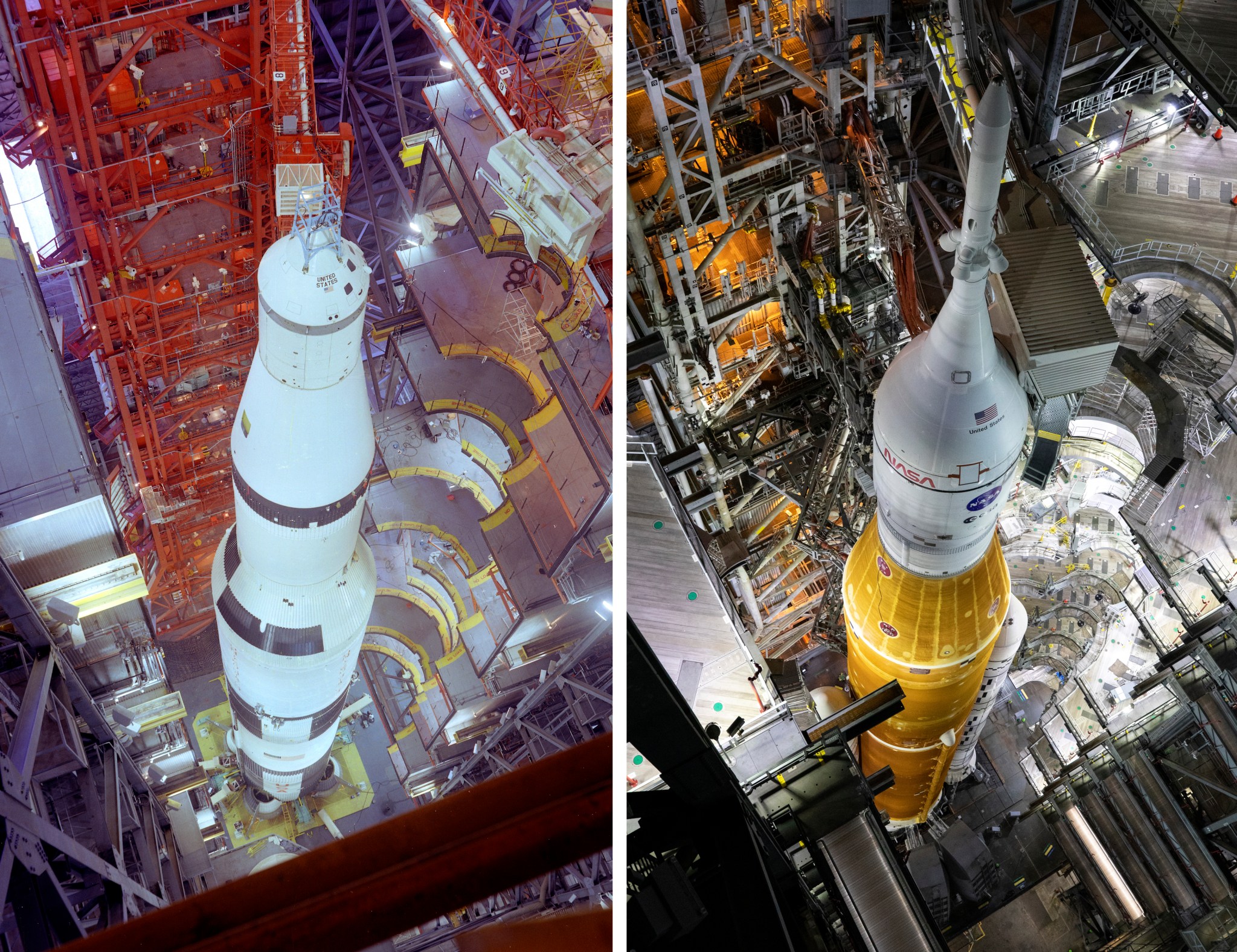
On the left, NASA’s 363-foot-tall Saturn V rocket for the Apollo 4 mission stands inside the Vehicle Assembly Building (VAB) at the agency’s Kennedy Space Center in Florida in preparation for roll out to the launch pad. Apollo 4 was Saturn V’s first launch and was designed to test all aspects of the rocket. The mission launched an uncrewed command and service module on Nov. 9, 1967, from Kennedy’s Launch Pad 39.
On the right, the 322-foot-tall Space Launch System rocket and Orion spacecraft for the Artemis I mission stands inside the VAB ahead of rollout for the mission’s wet dress rehearsal. Like Apollo 4, Artemis I is an uncrewed test flight that provides a foundation for human deep space exploration and demonstrates NASA’s commitment and capability to extend human existence to the Moon and beyond. The Apollo Program conducted two uncrewed Saturn V test flights – the Apollo 6 flight test followed after Apollo 4 – whereas Artemis I is the only uncrewed flight planned to precede the Artemis II flight that will send astronauts inside Orion to the Moon. Photo credit: NASA/Glenn Benson
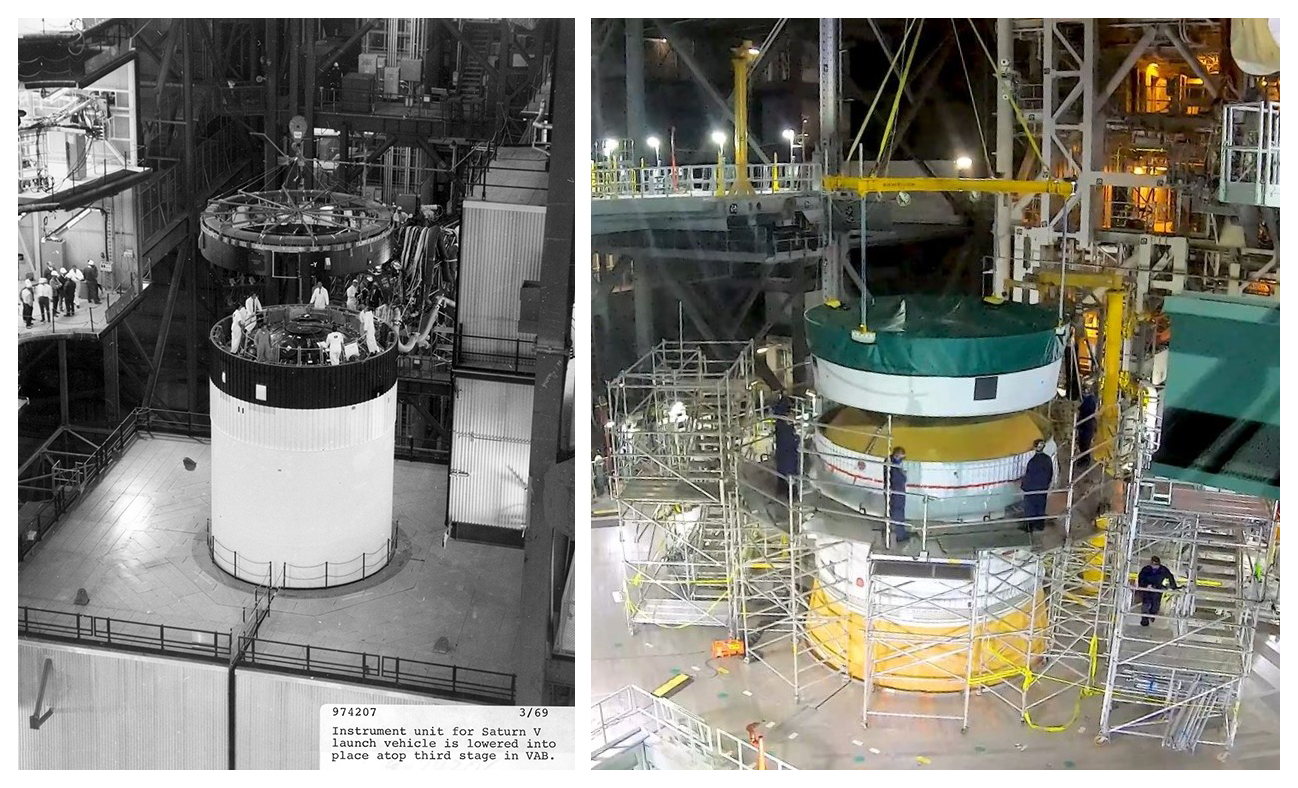
On the left, the instrument unit for the Apollo 11 mission is lifted in preparation for stacking atop the Saturn V rocket inside Kennedy Space Center’s Vehicle Assembly Building (VAB) in Florida. The instrument unit served as the rocket’s “nerve center,” providing guidance and control, command and sequence of functions, telemetry, and environmental control. Apollo 11 was NASA’s first lunar landing mission.
On the right, the five-foot-tall Orion stage adapter for the Artemis I mission is lifted in preparation for stacking atop the Space Launch System (SLS) rocket inside the VAB. The stage adapter, the last piece of the SLS rocket to be stacked before the Orion spacecraft is added to the top of SLS, connects the Interim Cryogenic Propulsion Stage to Orion and houses the secondary payloads. After Orion separates from the SLS rocket and heads toward the Moon, the shoebox-sized payloads will release from the Orion stage adapter to conduct their own science and technology research missions. Just as the Apollo capsule rode atop the Saturn V rocket, the Orion spacecraft rides at the top of the SLS rocket. Orion will soon be added to the SLS rocket to complete the Artemis I stack. Photo credit: NASA
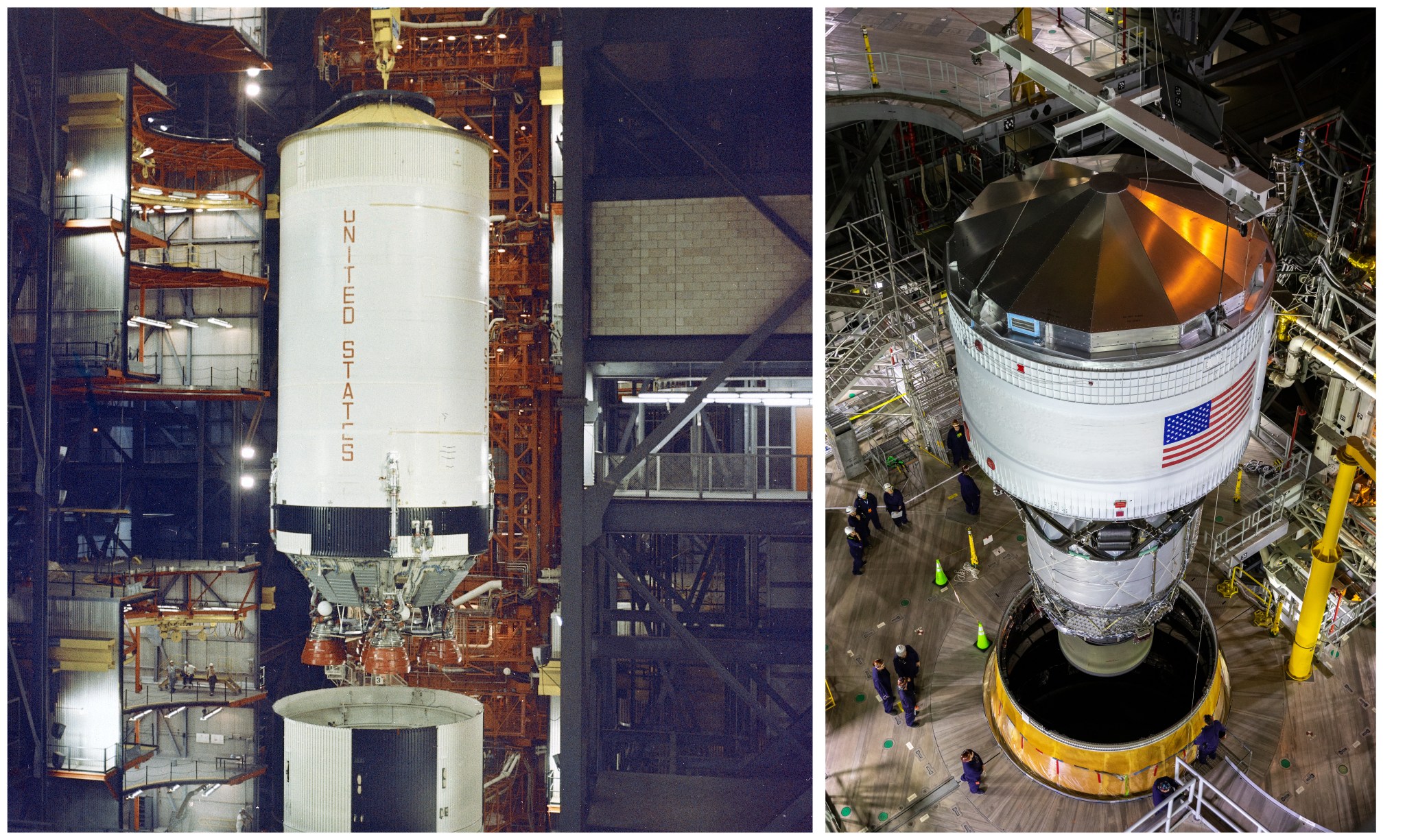
On the left, the second stage of the Saturn V rocket is stacked on top of the rocket’s first stage inside the Vehicle Assembly Building at NASA’s Kennedy Space Center in Florida. Used during the Apollo Program in the 1960s and 1970s, Saturn V sent the first humans to the Moon.
On the right is the Space Launch System rocket’s Interim Cryogenic Propulsion Stage (ICPS) getting ready for stacking on the launch vehicle stage adapter for the Artemis I mission. The ICPS is a liquid oxygen and liquid hydrogen-based system that will give the Orion spacecraft the big in-space push needed to fly beyond the Moon. The next component to be stacked on top of ICPS will be the Orion stage adapter, which will connect the ICPS with the spacecraft. Photo credit: NASA/Kim Shiflett
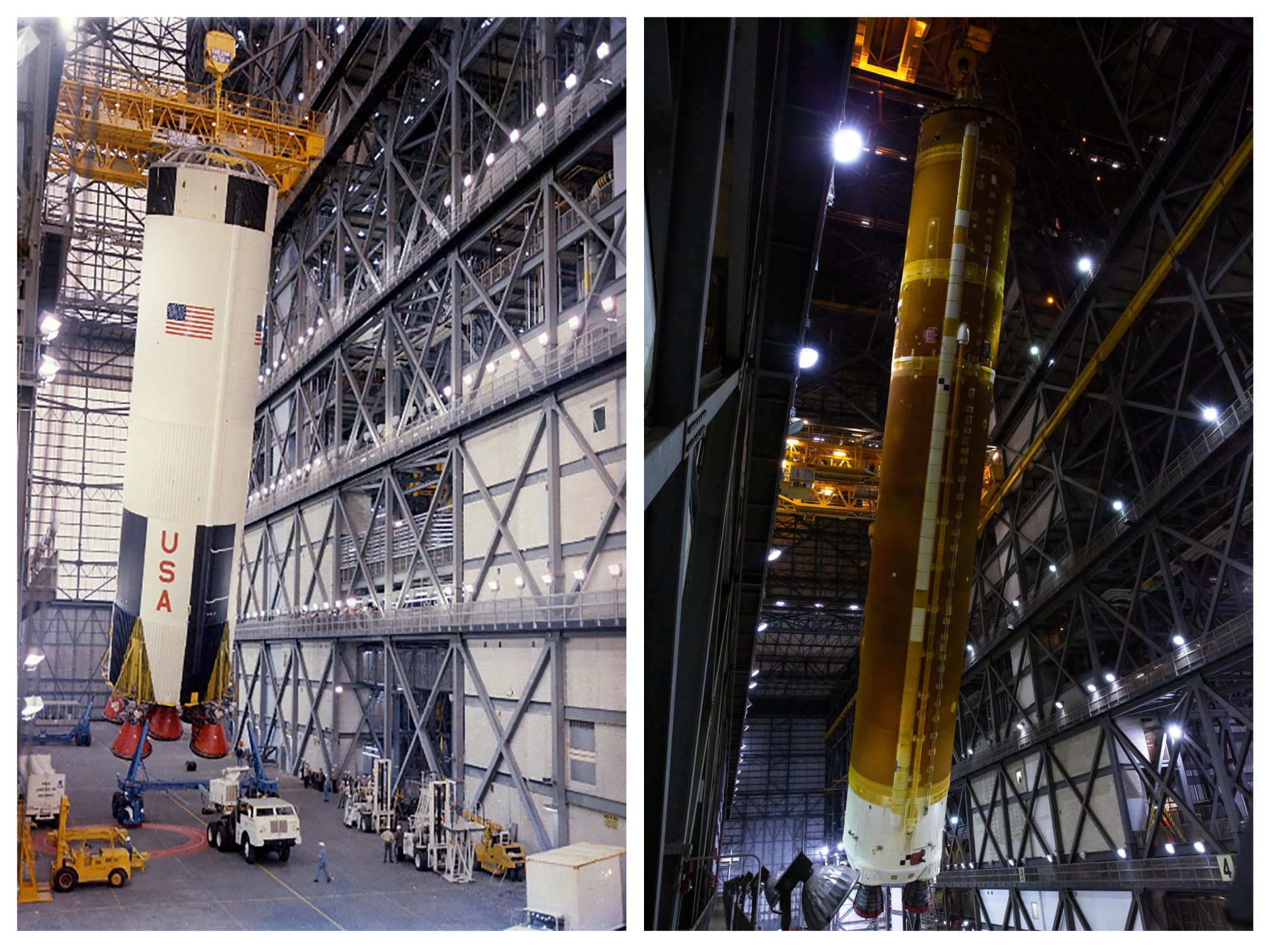
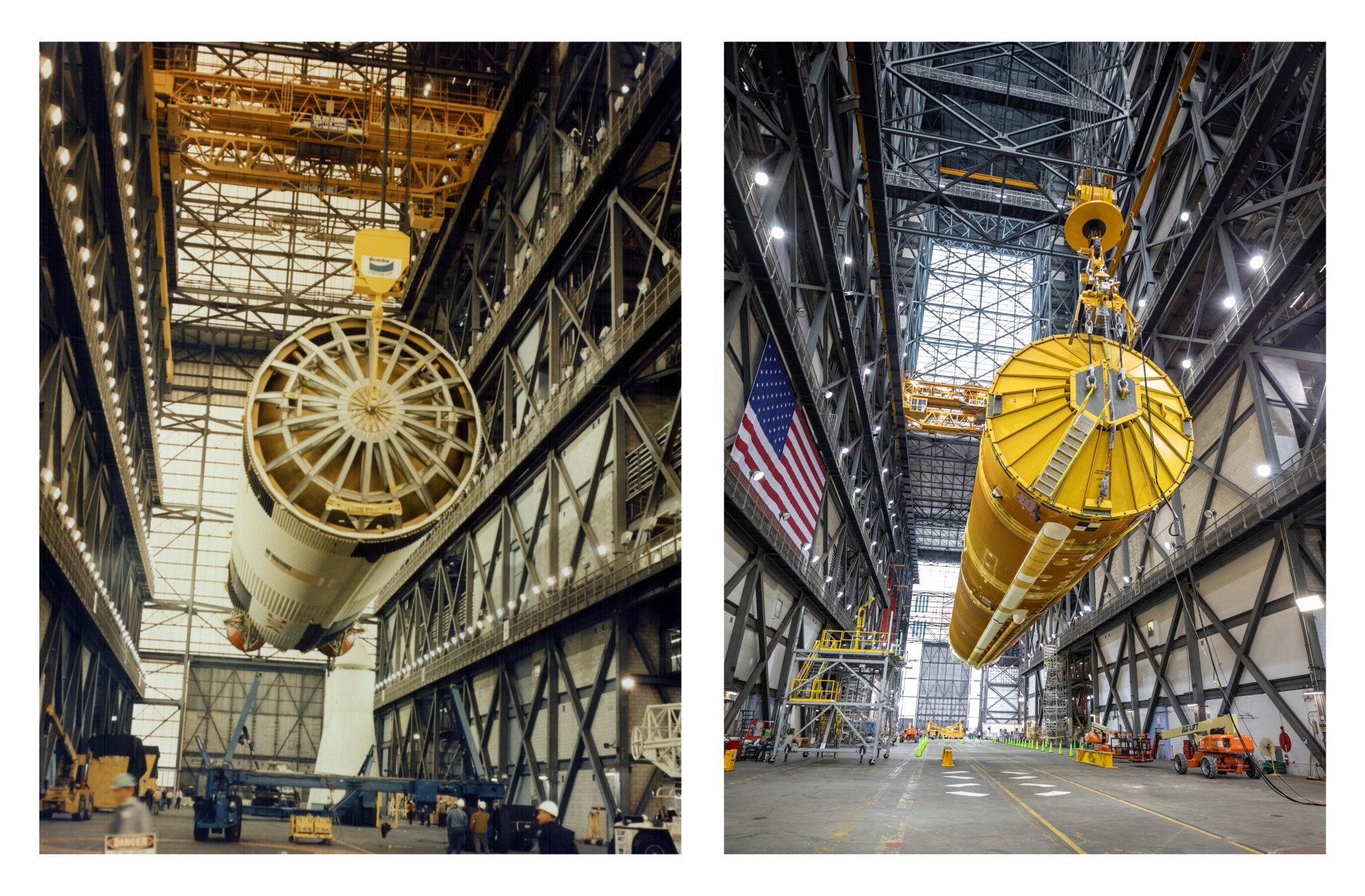
On the left, the first stage of the Saturn V rocket is lifted to get stacked on the mobile launch platform inside NASA’s Kennedy Space Center Vehicle Assembly Building (VAB) in Florida in preparation for its upcoming launch. This was the first stage of NASA’s first Moon rocket for the Apollo Program.
On the right is the NASA Space Launch System (SLS) rocket’s core stage lifted to get attached between the twin solid rocket boosters for the upcoming Artemis I mission. The core stage and boosters are in place on top of the mobile launcher inside the iconic VAB, the same place the Saturn V rocket was assembled for launch. With the core stage added, the next component to get stacked will be the launch vehicle stage adapter. The adapter connects the core stage to the interim cryogenic propulsion stage, the upper stage of the SLS rocket that provides the extra boost needed to send the Orion spacecraft 40,000 miles beyond the Moon, farther than any spaceship qualified to safely carry humans has ever ventured. Photo credit: NASA/Cory Huston
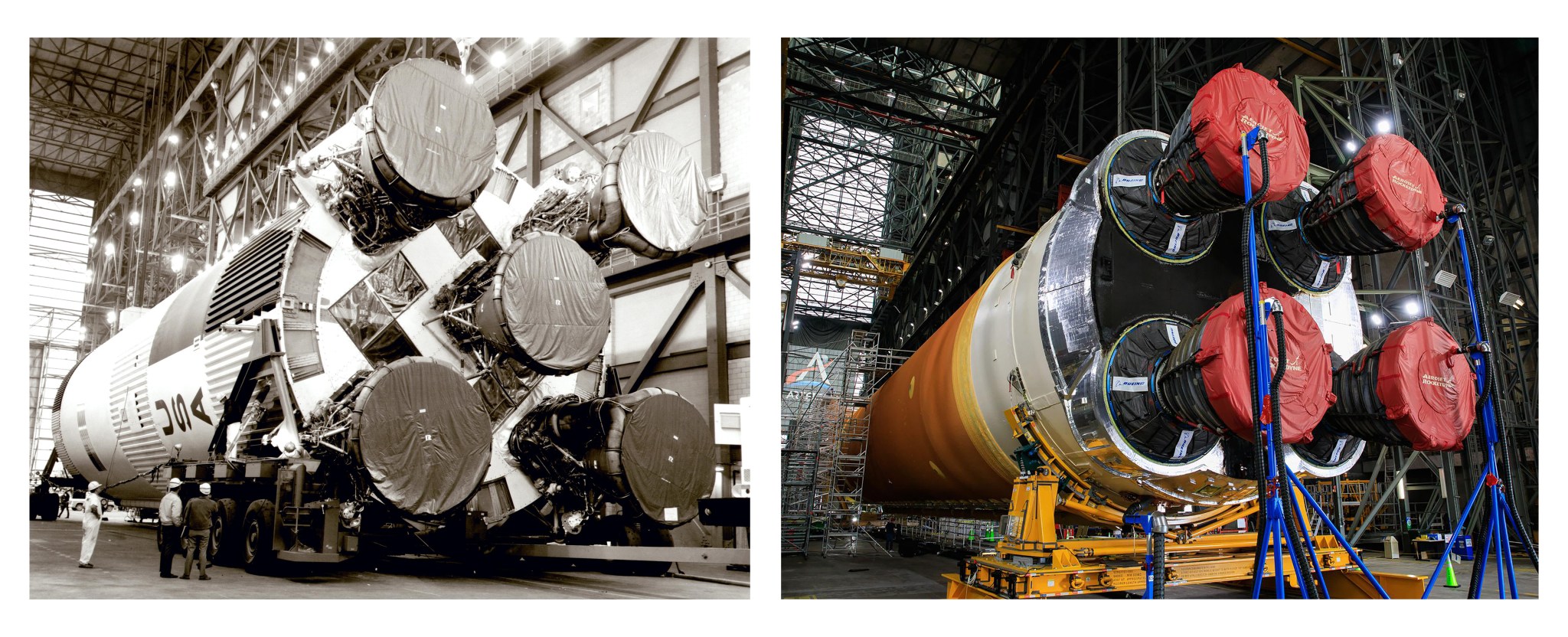
On the left, the first stage for the Apollo 11 Saturn V rocket sits horizontally atop the mobile transporter inside the transfer aisle of the iconic Vehicle Assembly Building (VAB) in NASA’s Kennedy Space Center in Florida. This was the first stage of the rocket that sent NASA astronauts Neil Armstrong, Buzz Aldrin, and Michael Collins to the Moon under the Apollo Program in 1969.
On the right is NASA’s Space Launch System (SLS) core stage for the Artemis I mission inside the transfer aisle of the VAB after it arrived from the agency’s Stennis Space Center in Mississippi aboard the Pegasus barge, April 29, 2021. Moving forward, teams with Exploration Ground Systems and lead contractor Jacobs will prepare the 212-foot-tall core stage for integration with the completed stack of the twin solid rocket boosters atop the mobile launcher ahead of the Artemis I launch. Unlike the Saturn V rocket, which had three rocket stages, SLS is powered by the mighty core stage – with two solid rocket boosters strapped alongside – and the upper stage, called the Interim Cryogenic Propulsion Stage, which provides the power to send the Orion spacecraft toward the Moon. The core stage is the world’s tallest rocket stage and serves as the backbone of the rocket, supporting the weight of the payloads, upper stage, and the Orion spacecraft. SLS will produce 15% more thrust than Saturn V during liftoff and ascent. The Saturn V rocket led America’s journey to the Moon, but SLS will have the capability to take humankind to the Moon and farther than ever before. Photo credit: NASA
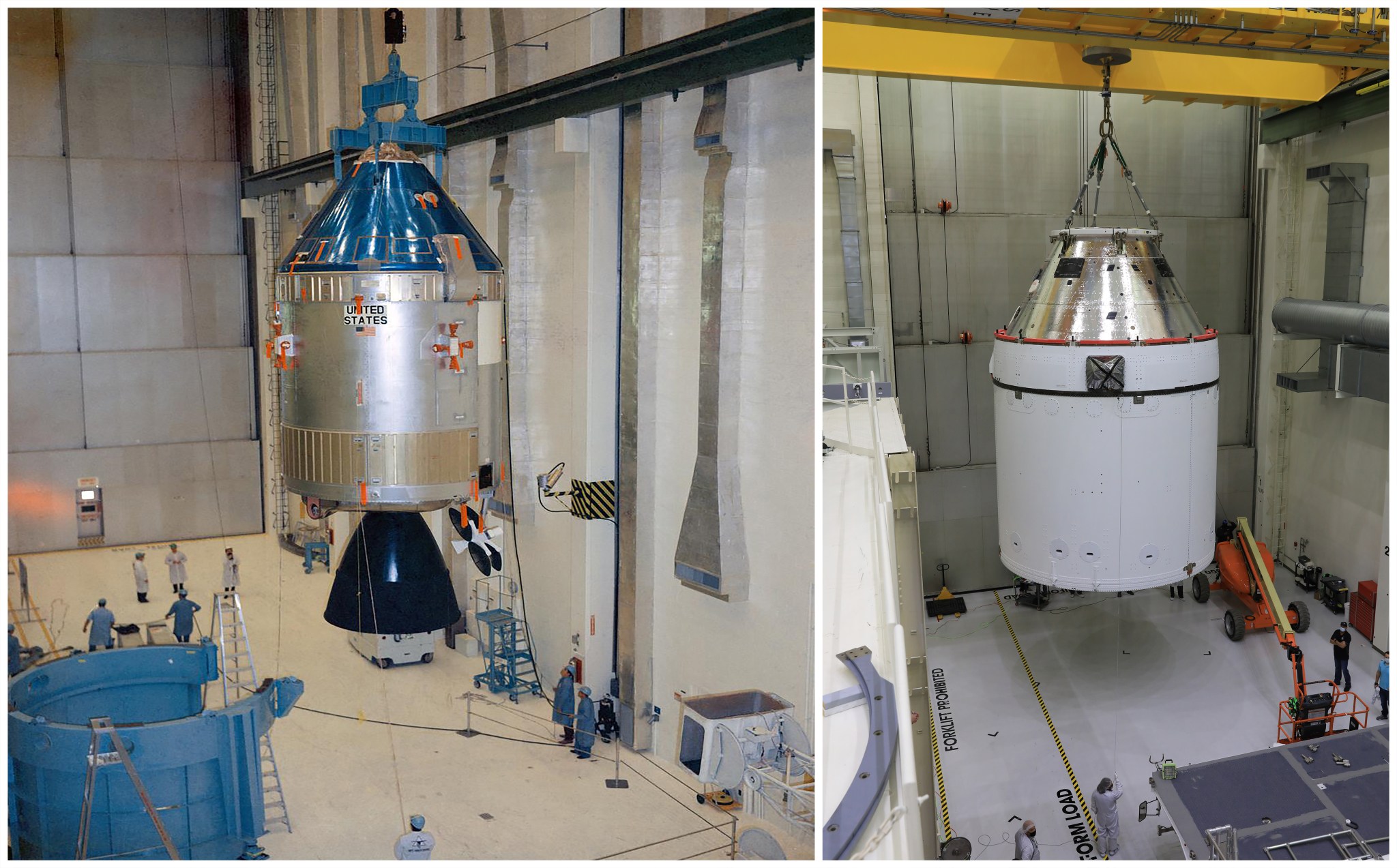
On the left, the spacecraft for Apollo 10, with its Command and Service Modules attached, is moved to a work stand for mating to a lunar module adapter inside the Manned Spacecraft Operations Building (now the Neil Armstrong Operations and Checkout Building) at NASA’s Kennedy Space Center in Florida on Jan. 31, 1969. This spacecraft was flown on the fourth crewed mission for the Apollo Program.
To the right is the Orion spacecraft, the capsule that will fly around the Moon on the Artemis I mission, being lifted out of a processing work stand and onto a transporter inside the Neil Armstrong Operations and Checkout Building on Jan. 14, 2021. With assembly of the spacecraft now complete, teams recently moved the spacraft to the Multi-Payload Processing Facility for fueling and servicing ahead of launch later this year. This uncrewed flight test of the Orion spacecraft and Space Launch System rocket will pave the way for crewed flights to the lunar surface. While the two spacecraft may look similar, Orion is larger and can fit more crew members than Apollo. The spacecraft is also much more technologically advanced. Compared to Apollo’s single flight computer, Orion has two simultaneously operating redundant flight computers. Each of these includes two redundant computer modules, giving it a total of four redundant systems. In addition, one of Orion’s redundant computers is only three quarters the weight of the sole computer aboard Apollo. One Orion computer also has 128,000 times more memory and is 20,000 times faster. Photo credit: NASA

























